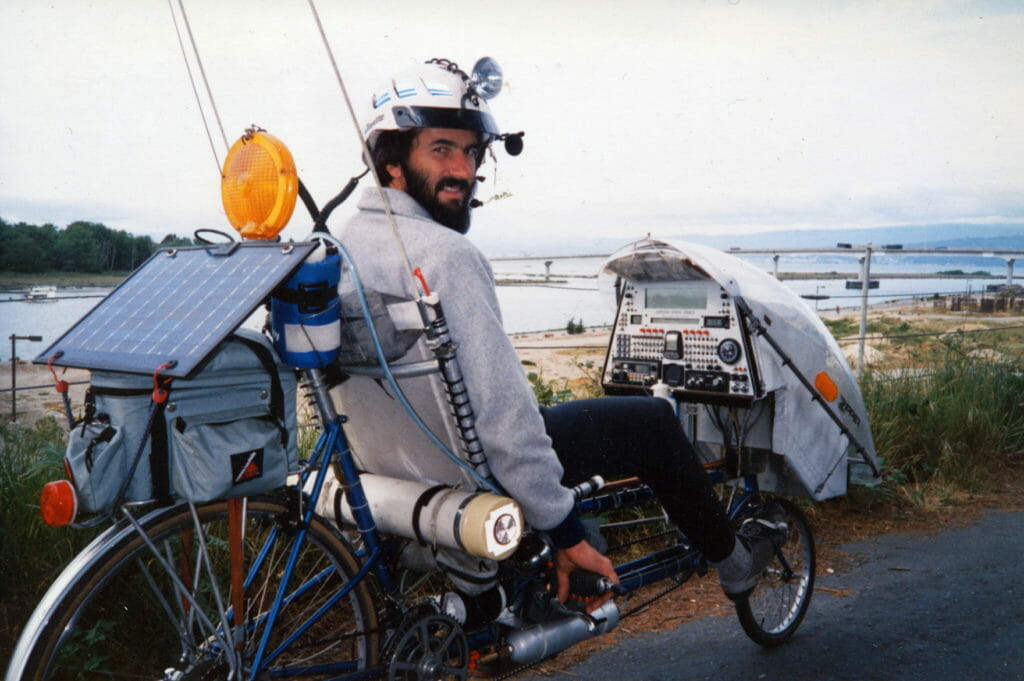
Adventures in South Ecotopia
by Steven K. Roberts
Eureka, California
November 28, 1986
After the 18 miles of insanity, we rode on to Arcata, “where the 60’s meet the sea,” and immediately began finding friends. Another of those surprises: there (and here, and here and there) prosper the values and attitudes that made the 60’s what they were — not in a degenerate way, but in a productive and creative one. Social consciousness lives! It’s a mature and quiet force, unlike the frenzy of days gone by that became de rigeuer for everyone under 30. Dig it? I mean… remember how confusing it was when you started meeting people who acted like hostile rednecks but looked just like gentle hippies? Most disturbing, wasn’t it? That’s what happens when style outweighs substance. But today’s hippiedom is a thoughtful lifestyle, not just the way to be in style.
The famed hallmarks of the 60’s — strange music, long hair, and dope — are but the textural backdrops in what has become a quiet, unaggressive community. Fashion has long since moved on (mercifully), leaving people who care about ecology and world peace to do what they can, for the most part so passively that the effects are but a gentle breeze in the absurd maelstrom of current events. But it matters, and they care, and it felt good to be in a place where people still believe in something other than abstract entities and their personal bottom lines.
We stayed at the Humboldt State Campus Center for Appropriate Technology for a couple of days, wandering the well-cultivated grounds through the shadows of windmills and solar collectors. Dinners had the feel of family, and nobody even asked how much my bike cost (one of the first questions in anyplace even close to Yuppiedom). I began writing a Whole Earth Review article, invigorated by an atmosphere more fitting than a xerox motel room or suburban vinyl tabletop. Quiet music. Good company. Smells of teas and spices, composting toilet and vegetable garden. (And of course, we did a bit of local media while there, as well as an earlier interview in Eureka.)
And then on to Eureka. “Don’t go there!” said our Arcata friends. “Come on down!” said our Eureka friends. The balance tilted, as always, in favor of change, and we rode 8 lazy miles to the Samoa Cookhouse — an old logging camp tradition that serves up an all-you-can eat mega-breakfast, ideal for cyclists. Pain and pleasure… raw gluttony… new insights into the term “lumbering.” Torpid and heavy we crossed the bridge and stumbled into yet another culture — another unexpected treat in what has become a lifestyle sampler of infinite scope.
Humboldt County is the Mecca of kinetic sculpture. Every year, Eureka is the scene of strange madness as 40-50 amphibious human-powered vehicles cover a 38-mile course of highway, water, and mud. Some racers are bent on sleek efficiency; most are bent on artistic fun — and it is with those of the latter category that we find ourselves staying. Through an unplanned sequence of serendipitous events, we fell immediately into a house-sitting deal… a chance to stop for a week and attempt to hit about 50,000 keys in the right order, ideally yielding a couple of magazine articles on the eve of deadline. Procrastination followed by despair: nothing has changed, even as everything changes.
So here I am, on Thanksgiving night, fresh from dinner with an exquisitely eccentric friend in Ferndale (more on the character of that intriguing place next week), pattering away on a lashed-together desk of plywood and C-clamps as a cat half-dozes beside me. Yes, here I am again: settled into a place I’d have never imagined a week ago, as much at home as ever. It’s not even strange anymore. We watched ourselves on San Francisco’s Evening Magazine last night — saw the “world’s smartest bicycle” laden with computers and solar panels — and realized with a start that it was US, that we are still a curiosity even as we settle into the journey’s routine. What’s so bizarre about a couple of high-tech nomads?
It’s those around us who we find curious, not ourselves. That’s probably why I still haven’t gotten around to explaining how this machine works. With all the wonders of the planet to explore, how could I remain obsessed with a bicycle — even if it does happen to talk?

